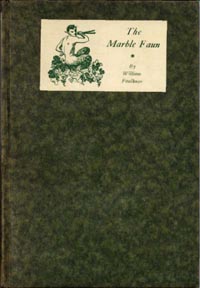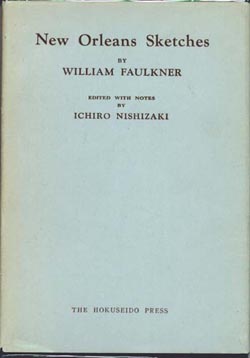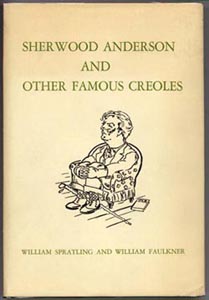

|
Apprentice Years |
The youthful and largely imitative poems of the Ole Miss years changed steadily as Faulkner's reading and experiences expanded. The months of formal schooling were only the beginning of a period full of experiments in writing poetry, prose, and drama, of working in a bookstore in New York City, living in Greenwhich Village and associating with other writers and artists, and continuing his self education through study of Melville, Conrad, Balzac, Flaubert, Dickens, Cervantes, and Dostoyevsky.
 |
William Faulkner.The Marble Faun. Boston: The Four Seas Company,1924.The seemingly interminable writing, submissions to publishers, and rejections finally did reach an end. In May of 1924, Faulkner's long-time friend and admirer, Phil Stone, sent a note to the Four Seas Company in Boston asking if they would publish a collection of poems by an unknown writer if the cost of publication were covered. The answer was yes, and within a few months an agreement was reached to publish 1,000 copies of The Marble Faun for $400. The collection consists primarily of pastoral poems, most written five years earlier, but here reworked into a tighter cycle. There are nineteen poems that present a heavy dose of fauns, nymphs, shepherds, and shepherdesses. Perhaps that was one reason the book did not sell very well. But another possibility is that in Oxford, those who might have been interested in a new book of poetry were more concerned with the boll weevil and typhoid fever, both of which were attacking Lafayette County that year. The most likely reason, however, is that readers agreed with the publisher, Edmund R. Brown, that "it is not really a very good book of poetry." Critics generally concurred that the poems show promise, but are immature with passages of quality almost lost in "stretches of creditable but not remarkable verse." Certainly in the 1920s, no one could imagine that this slim volume would become one of the scarcest and, therefore, most sought after of American publications. |
William Faulkner.New Orleans Sketches.Tokyo: Hokuseido Press, 1955.Although Faulkner continued to write poetry in the years after the appearance of The Marble Faun, he turned increasingly to prose. Much of his work took the form of essays, and several were actually accepted for publication. Faulkner had traveled to New Orleans ostensibly to become acquainted with Sherwood Anderson and to wait for a ship to Europe that would exchange work for passage. He did indeed become friends with Anderson, but, in addition, he met John McClure, a journalist who worked for the New Orleans Times-Picayune and who helped edit The Double Dealer, a literary magazine that had already published one of his poems and which was active in promoting the work of the "up-and-coming" writers such as Ernest Hemingway, Robert Penn Warren, and Thornton Wilder. McClure's friendship led to acceptance by the Times-Picayune of a sketch entitled "The Mirror of Chartres Street," which developed into a series of essays based on observation of the local scene. The sixteen stories and sketches were published in the Sunday feature section between February and September, 1925. The first appearance in book form was this Tokyo publication edited with notes in Japanese and text in English by Ichiro Nishizaki, which reprints thirteen of the sketches. |
 |
 |
Sherwood Anderson & Other Famous Creoles; a Gallery of Contemporary New Orleans. Drawn by William Spratling & arranged by William Faulkner. New Orleans: Pelican Bookshop Press,1926.The friendship between Faulkner and Sherwood Anderson was warm at first. Anderson, in New Orleans in 1924 and 1925, was a major figure to most of the writers gathered in the French Quarter. The two liked one another from their first meeting, and became quite agreeable companions. In addition, they used each other for material, Anderson probing Faulkner for a better understanding of the South, and especially of black-white relationships, and Faulkner learning more about modern art from Mrs. Eleanor Anderson, and borrowing characters, plots, and much advice from Anderson. Such closeness was the cause of the ultimate cooling of their relationship. Faulkner became so intimate with Anderson (the writer and the man) that he could write a 2,000 word essay on Anderson for the Dallas Morning News of April 26, 1925, that was perhaps a bit too honest and too astute. The essay is reprinted in this 1968 publication of New Orleans Sketches, and even the most humble man could not have been overly pleased with such "damning praise" from a younger, "student" writer. It may have been the two-page parody of Anderson's style and some of his views published as an introduction to this collection of sketches drawn by his friend William Spratling that finally caused the friendship with Anderson to disintegrate. Faulkner's parody was subtle and kindly, but it appeared just a few months after Hemingway's much more destructive sneer published in "The Torrents of Spring." Anderson was hurt by what he saw as attacks from young writers he had befriended, and both Spratling and Faulkner eventually regretted "the unhappy caricature affair." Pelican Press printed 400 copies which were all sold within a week at a dollar and a half each, soon to be followed by 150 more. This copy is number 198 of the first 250 numbered copies. |
William Faulkner.Helen: a Courtship.Oxford, Mississippi: Yoknapatawpha Press, and New Orleans, Louisiana: Tulane University, 1981.Throughout these years of apprenticeship, travel, and experimentation, Faulkner strongly loved only a very few women. The first was Estelle Lida Oldham (who would become his wife). Another was Helen Baird whom he first met at parties in New Orleans. During the early summer of 1925 they became better acquainted while he was visiting Phil Stone's family in Pascagoula, Mississippi, where they had a summer cabin. The Baird family also spent vacations in this beautiful coastal community. Faulkner's attraction developed into love and a proposal of marriage. Although Helen refused, the relationship resulted in a wonderful sequence of fifteen sonnets which he wrote mostly while enjoying his long-awaited trip to Italy, France, and England during the months of July to October, 1925. When he returned home he copied the poems in meticulous lettering, bound them, and presented them to Helen. That single copy was the only one extant until this facsimile edition was published fifty-five years later. |
 |